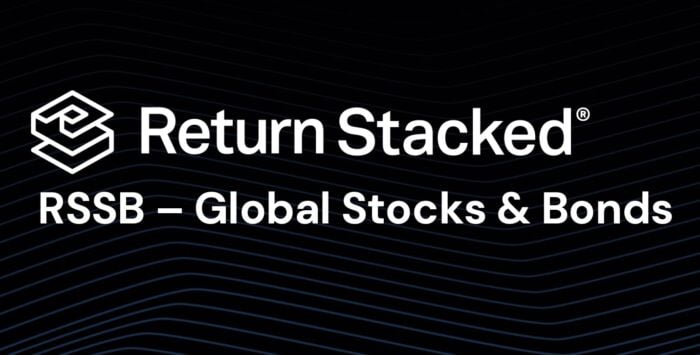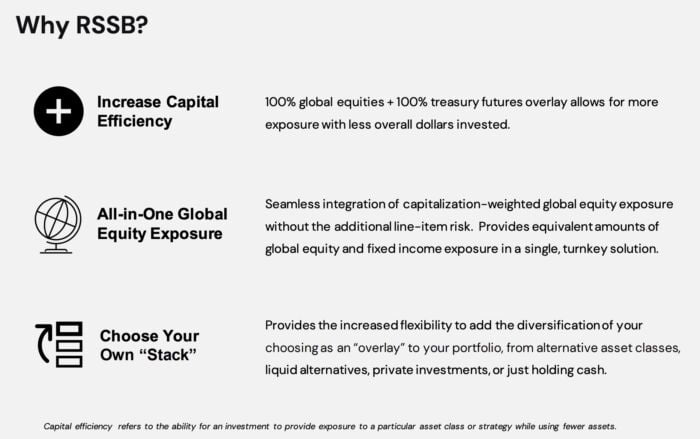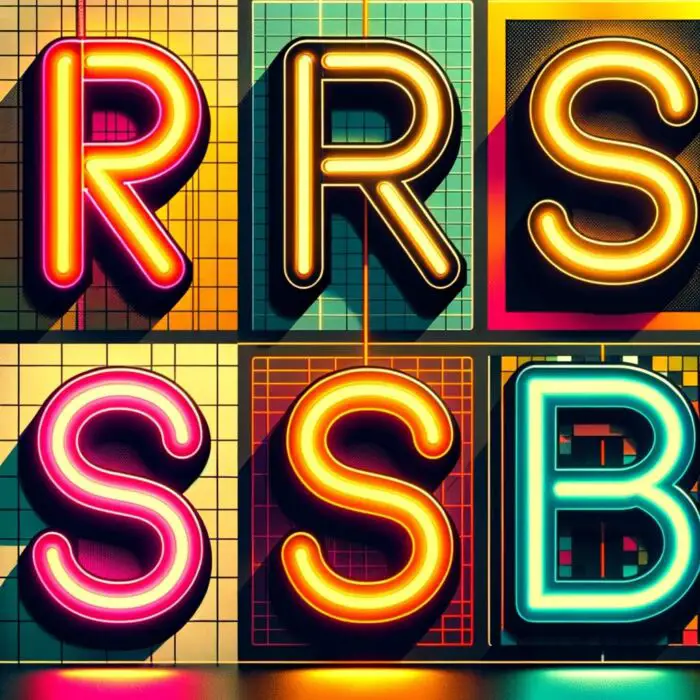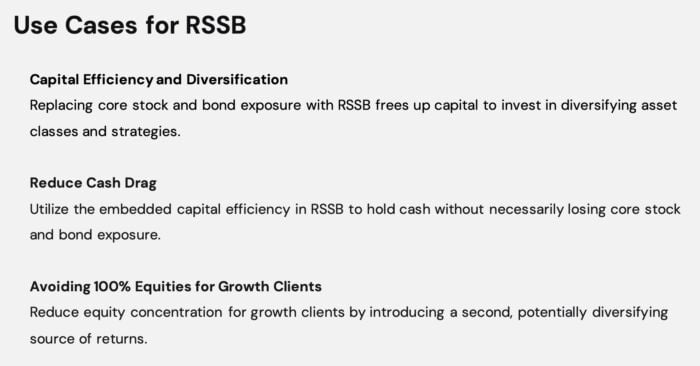I believe we’ve officially entered into the golden era of capital efficient investing!
Leading the way in this glorious rampage is Return Stacked Portfolio Solutions.
This year alone they’ve launched three unique puzzle pieces that are each 200% canvas products.
As an expanded canvas investor, I’m drooling over the potential to return stack them in as creative a manner as possible.
Yeah, I’m gobbling them up like Pacman.
Anyhow, the latest and greatest in the official lineup is RSSB ETF.
It’s better known as Return Stacked Global Stocks & Bonds ETF.

Hence, I’m ecstatic to have Corey Hoffstein back to explain the unique features of this particular fund.
Without further ado, let’s turn things over to Corey!

Corey Hoffstein: CIO of Newfound Research
Corey Hoffstein, co-founder and Chief Investment Officer at Newfound Research, leads a quantitative investment firm known for its alternative investment strategies and capital-efficient solutions.
In his role at Newfound, Corey is responsible for directing quantitative research and steering the company’s overall strategic direction.
He earned a Bachelor of Science in Computer Science from Cornell University and a Master of Science in Computational Finance from Carnegie Mellon University.

Reviewing The Strategy Behind RSSB ETF (Return Stacked Global Stocks & Bonds ETF)
Hey guys! Here is the part where I mention I’m a travel content creator! This “The Strategy Behind The Fund” interview is entirely for entertainment purposes only. There could be considerable errors in the data I gathered. This is not financial advice. Do your own due diligence and research. Consult with a financial advisor.

These asset allocation ideas and model portfolios presented herein are purely for entertainment purposes only. This is NOT investment advice. These models are hypothetical and are intended to provide general information about potential ways to organize a portfolio based on theoretical scenarios and assumptions. They do not take into account the investment objectives, financial situation/goals, risk tolerance and/or specific needs of any particular individual.
What’s The Strategy Of RSSB ETF?
For those who aren’t necessarily familiar with a “‘return stacked’ capital efficient” style of asset allocation, let’s first define what it is and then explain this strategy in practice by giving some clear examples.

Most investors will acknowledge that more diversification is generally favorable to less. By combining uncorrelated assets, wealth can compound more consistently and investors can achieve their financial plans with more certainty.
The best non-correlated options tend to be alternative assets like gold and commodities as well as alternative strategies like managed futures, systematic global macro and other liquid alts. Unfortunately, most investors today allocate little to no money to these areas? Why?
In my experience, it is because adding alternatives also means subtracting exposure to core stocks and bonds. This can create significant tracking error and lead to substantial relative underperformance during decades like the 2010s when stocks and bonds thrived and many alternatives languished.
Return stacking aims to solve this problem by providing investors with a “yes and” solution rather than an “either/or” decision.
It does this by combining multiple exposures into a single fund. For example:
- In the Return Stacked® Bonds & Managed Futures ETF (RSBT), for every $1 invested, we provide $1 of exposure to bonds and $1 of exposure to a managed futures strategy.
- In the Return Stacked® U.S. Stocks & Managed Futures ETF (RSST), for every $1 invested we provide $1 of exposure to large-cap U.S. equities and $1 of exposure to a managed futures fund.
- In our Return Stacked® Global Stocks & Bonds ETF (RSSB), for every $1 invested we provide $1 of exposure to Global Equities and $1 of exposure to U.S. Treasuries.
By swapping out a portion of core stock or bond exposure with the respective two-for-one pre-packaged ETF, we are able to reintroduce the core exposure AND stack managed futures on top of their original portfolio.
For more on return stacking, you can visit our “what is return stacking” primer.


Unique Features Of Return Stacked Global Stocks & Bonds Fund RSSB ETF
Let’s go over all the unique features your fund offers so investors can better understand it. What key exposure does it offer? Is it static or dynamic in nature? Is it active or passive? Is it leveraged or not? Is it a rules-based strategy or does it involve some discretionary inputs? How about its fee structure?

For every $1 invested, the Return Stacked® Global Stocks & Bonds ETF (RSSB) is designed to provide $1 of global equity exposure and $1 of U.S. Treasury exposure.
The relative target exposure between global stocks and bonds is static.
The global equity exposure simply seeks to provide broad market-cap weighted global equity exposure (e.g. MSCI ACWI or FTSE All World), providing access to U.S., foreign developed, and emerging market equities. There is no active stock-picking component.
The U.S. Treasuries exposure is (at launch) a simple equal-weight ladder of 2-, 5-, 10-, and ultra U.S. Treasury futures.

What Sets RSSB ETF Apart From Other Asset Allocation Funds?
How does your fund set itself apart from other “asset allocation” funds being offered in what is already a crowded marketplace? What makes it unique?

In a single phrase: “capital efficiency.” By providing $2 of exposure for every $1 invested, investors can allocate half the capital to achieve the same stock and bond exposure. This frees up room in their portfolio for the introduction of other diversifiers.
This approach effectively allows investors to “overlay” any exposure they want on top of their core stock and bond portfolio. As long as that exposure outperforms the cost of leverage embedded in RSSB, it should introduce additional returns to the portfolio. Carefully chosen, it may even introduce diversification benefits.
Unlike our previous funds, which stack core betas with alternatives, RSSB allows investors to choose the alternatives they want to stack in their portfolio.

What Else Was Considered For RSSB ETF?
What’s something that you carefully considered adding to your fund that ultimately didn’t make it past the chopping board? What made you decide not to include it?

One of the big questions for us was, “how much leverage?” In fact, the fund was initially filed as a 1.5x levered 60/40 strategy.
However, after a lot of client conversations, we realized that the “$1 of X and $1 of Y for every $1 invested” model made the mental math of return stacking a lot easier for allocators.
When Will RSSB ETF Perform At Its Best/Worst?
Let’s explore when your fund/strategy has performed at its best and worst historically or theoretically in backtests. What types of market conditions or other scenarios are most favourable for this particular strategy? On the other hand, when can investors expect this strategy to potentially struggle?

Evaluated as a stand-alone strategy, RSSB’s performance will be almost entirely driven by the performance of global stocks and U.S. Treasuries. If they perform well, at the same time, RSSB will perform well. If they perform poorly in tandem – such as in 2022 – RSSB will suffer.
That said, RSSB is meant to be used as a tool for capital efficiency. So, while a 100% stock / 100% bond portfolio will perform twice as poorly as a 50% stock / 50% bond portfolio in an environment like 2022, if we only need to allocate half our capital, then the losses should be equivalent on a dollar basis.
As a more subtle point, since the fund uses leverage enabled by U.S. Treasury futures, the cost of leverage is an important component of returns. Ultimately, the return of RSSB should be approximately equal to the return of global equities plus the return of a ladder of U.S. Treasury bonds minus the cost of financing. Historically, this cost of financing in U.S. Treasury futures has been near U.S. Treasury Bill rates. This means that we’d expect the fund to perform better, on an absolute basis, when the yield curve is positively sloped.
We would stress, however, that the fund is meant to be used as a tool for capital efficiency, allowing investors to introduce any overlay on their portfolio that they’d like. Used this way, investors can worry less about the dynamics of the yield curve and simply ask whether they believe whatever they’re stacking can overcome the embedded cost of leverage.
For example, assume an investor allocates 50% of their portfolio to global stocks and 50% to U.S. Treasuries. They could, in theory, replace their portfolio with a 50% position in RSSB and 50% in short-term U.S. Treasury bills. We would expect these two portfolios to have nearly identical returns.
If the investor then sells the Treasury Bills and buys some alternative exposure – like commodities, gold, or a hedge fund strategy – they have effectively retained their 50% stock / 50% bond profile but added a 50% alternatives profile on top. So long as that alternatives profile outperforms the U.S. Treasury Bills they sold to make room, it should be additive versus their prior portfolio.


Why Should Investors Consider Return Stacked Global Stocks & Bonds RSSB ETF?
If we’re assuming that an industry standard portfolio for most investors is one aligned towards low cost beta exposure to global equities and bonds, why should investors consider your fund/strategy?

That is precisely why we believe investors should consider our fund! RSSB allows investors to maintain their beta exposure while choosing their own alternative exposures to introduce as an overlay.

How Does RSSB ETF Fit Into A Portfolio At Large?
Let’s examine how your fund/strategy integrates into a portfolio at large. Is it meant to be a total portfolio solution, core holding or satellite diversifier? What are some best case usage scenarios ranging from high to low conviction allocations?

Ideally, RSSB will serve as a capital efficient building block for investors. By that, we mean it is used to replace existing core stock and bond exposure and make room for whatever overlay allocators want to introduce.
There are other potential use cases, however. For example, many financial advisors will keep a certain percentage of a client account in cash (either for convenience or for compliance reasons). RSSB can be used to help reduce potential cash drag.
Finally, many young, growth investors allocate 100% of their capital to equities. Replacing some equity with RSSB can allow for the introduction of a second, hopefully diversifying, return stream in their portfolio.
source: Return Stacked® Portfolio Solutions on YouTube

The Cons of RSSB ETF
What’s the biggest point of constructive criticism you’ve received about your fund since it has launched?

Many investors are simply averse to leverage. And, make no mistake, return stacking is an application of leverage.
The fear of leverage is understandable: if you look at just about every major financial catastrophe, you’ll find leverage lurking at the crime scene. But it is usually concentrated leverage.
What we’re specifically advocating for is NOT levering up more of the same risk, but rather utilizing “defensive” leverage by stacking lowly correlated assets and strategies as a way to better unlock the potential benefits of diversification. We believe that return stacking can not only help investors introduce alternatives in a way that can improve expected portfolio results, but also introduce alternatives in a manner that is behaviorally sustainable.

The Pros of RSSB ETF
On the other hand, what have others praised about your fund?

We are excited at the number of people who see our funds the same way as we do: pre-stacked building blocks that enable a variety of different portfolios to be constructed.
Some may elect to create a small overlay on their very traditional stock-bond portfolio. Others have created examples where they re-think what an “all weather” portfolio might look like, creating levered, balanced allocations of stocks, bonds, commodities, and alternative strategies.
Our intention with launching Return Stacked ETFs (www.returnstackedetfs.com) is not to be prescriptive (though we do have opinions), but rather to provide the building blocks for informed investors to build the portfolios that are best for them. Having said that, we do offer clear assembly instructions via model portfolios for those advisors and institutions that want turnkey solutions and incorporate other pre-packaged funds and ETFs at Return Stacked Portfolio Solutions (www.returnstacked.com).

Learn More About RSSB ETF and Return Stacking Investing Strategies
We’ll finish things off with an open-ended question. Is there anything that we haven’t covered yet that you’d like to mention about your fund/strategy? If not, what are some other current projects that you’re working on that investors can follow in the coming weeks/months?

As I mentioned in the last answer, we see our funds as pre-stacked building block solutions and so, as you might expect, we plan to continue to launch different combinations of stacks in the coming months and years.
For financial professionals, we also offer model portfolios. These are turnkey portfolio solutions that implement return stacking concepts and are available in a variety of risk profiles. Advisors can implement them directly, customize them, or simply use them as inspiration. We plan on expanding our model lineup over the next several years.
We’ve also been working on several tools to allow investors to learn by getting their hands dirty. To date we’ve published two tools: the Return Stacking Visualizer and a Return Stacking Withdrawal Visualizer. The former allows investors to easily explore and backtest different return stacking concepts. The latter allows investors to explore how return stacking combinations can impact portfolio longevity and withdrawals. Both are currently available to financial professionals after they register on our website. We hope to expand this toolkit going forward.
Finally, we recognize that this concept will be novel for many, so education is a strong focus for us. So, we plan on publishing more content on our blog as well as our YouTube channel.

Connect With Corey Hoffstein & Return Stacked Portfolio Solutions
X/Twitter: X.com/@choffstein
YouTube: Youtube.com/@ReturnStacked
Website: ReturnStacked.com
source: ReSolve Riffs on YouTube
Nomadic Samuel Final Thoughts

I want to personally thank Corey Hoffstein at Return Stacked ETFs for taking the time to participate in “The Strategy Behind The Fund” series by contributing thoughtful answers to all of the questions!
If you’ve read this article and would like to have your fund featured, feel free to reach out to nomadicsamuel at gmail dot com.
That’s all I’ve got!
Ciao for now!
Important Information
Comprehensive Investment Disclaimer:
All content provided on this website (including but not limited to portfolio ideas, fund analyses, investment strategies, commentary on market conditions, and discussions regarding leverage) is strictly for educational, informational, and illustrative purposes only. The information does not constitute financial, investment, tax, accounting, or legal advice. Opinions, strategies, and ideas presented herein represent personal perspectives, are based on independent research and publicly available information, and do not necessarily reflect the views or official positions of any third-party organizations, institutions, or affiliates.
Investing in financial markets inherently carries substantial risks, including but not limited to market volatility, economic uncertainties, geopolitical developments, and liquidity risks. You must be fully aware that there is always the potential for partial or total loss of your principal investment. Additionally, the use of leverage or leveraged financial products significantly increases risk exposure by amplifying both potential gains and potential losses, and thus is not appropriate or advisable for all investors. Using leverage may result in losing more than your initial invested capital, incurring margin calls, experiencing substantial interest costs, or suffering severe financial distress.
Past performance indicators, including historical data, backtesting results, and hypothetical scenarios, should never be viewed as guarantees or reliable predictions of future performance. Any examples provided are purely hypothetical and intended only for illustration purposes. Performance benchmarks, such as market indexes mentioned on this site, are theoretical and are not directly investable. While diligent efforts are made to provide accurate and current information, “Picture Perfect Portfolios” does not warrant, represent, or guarantee the accuracy, completeness, or timeliness of any information provided. Errors, inaccuracies, or outdated information may exist.
Users of this website are strongly encouraged to independently verify all information, conduct comprehensive research and due diligence, and engage with qualified financial, investment, tax, or legal professionals before making any investment or financial decisions. The responsibility for making informed investment decisions rests entirely with the individual. “Picture Perfect Portfolios” explicitly disclaims all liability for any direct, indirect, incidental, special, consequential, or other losses or damages incurred, financial or otherwise, arising out of reliance upon, or use of, any content or information presented on this website.
By accessing, reading, and utilizing the content on this website, you expressly acknowledge, understand, accept, and agree to abide by these terms and conditions. Please consult the full and detailed disclaimer available elsewhere on this website for further clarification and additional important disclosures. Read the complete disclaimer here.







I guess I’m trying to understand the long range potential of a fund like RSSB. Say for instance if over the next 20 years in this fund stocks return say 7% a year and bonds 4% a year, can I really expect to do 11% CAGR minus fees? Really would like to see the math broken down in such a way to understand this better for this and other leveraged funds.